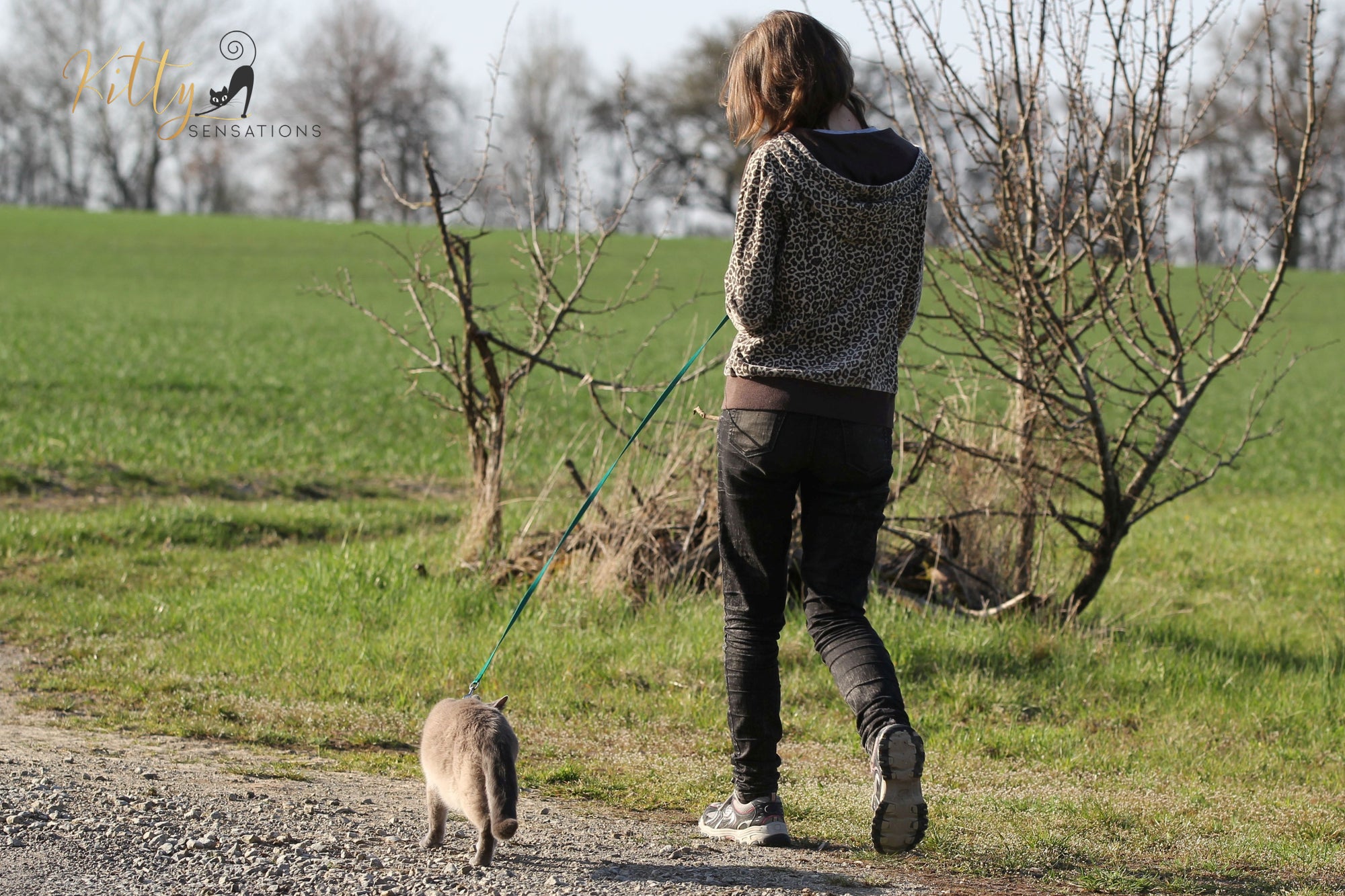I hope that you have already read our blogpost ‘Should you Walk Your Cat Outside on a Leash? Pros and Cons of Walking Your Cat Outside on a Leash’.
If, after reading the blogpost, you have decided that you would like to walk your cat on a leash, please make sure to follow all safety precautions.
Here we have compiled together a list of things to do before, during, and after walking your kitty on a harness and leash.

Before Walking Your Cat on A Leash:
1 – First and foremost, invest in a good quality harness and leash. The leash and harness should be strong and comfortable for your kitty. They should be a good fit for the size of your kitty. The harness should fit comfortably on your kitty. It should not be too snug and not too loose that it could slip out of your cat. The leash should not be too long as that can potentially strangle a cat, generally 4 feet long leash is recommended. Retractable leashes are generally not recommended for cats. Choose a leash and a harness that is specifically designed for a cat. Do not use a dog or other pet harness and leash on your cat. Two types of cat harnesses can be purchased, lead and vest. Most experts recommend vest harness as they can be more comfortable. But it depends on your cat.

Attach the leash to the harness. Do not attach a leash directly to your kitty’s collar, since cat’s have sensitive throats and necks and they can get throttled easily.

2 – Make sure that your kitty is microchipped, and has an ID tag, an LED light, and a bell on the collar.

3 – Make sure that your cat is neutered/spayed, and fully vaccinated.
4 – Get your cat used to the harness and the leash by leaving those around your kitty, while you are also watching. Let your cat touch and smell and play with the harness and the leash.
5 – Place the harness gently and in steps on your kitty and reward her for every step. Leave the harness on for small periods of time to get your kitty used to it. Please follow all safety and other instructions provided by the manufacturer of the leash and harness. Wearing a harness and a leash can be stressful for your kitty, make sure to gently ease your cat into it. For example, you can use small quantities of treats as rewards to introduce harness and leash to your kitty. Generally, a comfortable harness is one which allows for two fingers’ space between the harness and the kitty’s body.

6 – Once your kitty is comfortable with the harness, attach the leash to the harness and leave it on, supervised, for short periods of time to get your kitty used to the harness and the leash.
7 – Get your cat used to walking on a leash and harness inside your home before taking her outside on hiking or walking. Practice with walking with your kitty on leash around your home. See how your cat reacts to the leash and harness. If your cat is not comfortable, try changing to a more appropriate leash and harness, that is comfortable for your cat, safe, and acceptable to your cat. Do not leave harness and leash on your kitty for long periods of time.
8 - Try carrying your kitty outside on the desk, porch, outside of the door while carrying your kitty. Make your kitty comfortable with the outdoors.
9 – Once your kitty is comfortable with the harness and leash inside the home and comfortable with the outdoors, you can practice walking your cat in the yard or garden or the deck or porch or patio or other safe fenced outdoors or the apartment complex or some other safe and confined outdoor place. A catio might also be an option. Harness and leash your cat before venturing outside. Pick up and carry your kitty out of the door, even when harnessed and leashed. If you let your kitty walk outside, it can give her ideas that she can go outside on her own. Therefore, always carry your cat outside instead of letting her walk outside.

10 - See how your cat reacts to the leash and harness. Sit next to your kitty, listen to the outdoor sounds, smell the outdoors, and watch the outdoor sights, to get your kitty used to the outdoor environment. Let your kitty explore the surroundings while on the leash. If your cat seems frightened or stressed quickly bring her inside and release her from harness and leash. Do not leave harness and leash on your kitty for long periods of time.
11 - Once your cat is comfortable with the leash and harness in safe and confined outdoors, then try practicing walking the cat with leash in a park or a sidewalk or an urban trail, for a short time, perhaps for about 5 minutes at a time and then progressively increase it as your cat becomes more and more comfortable. Always be prepared to pick your kitty if there are signs of distress, discomfort, or stress.
12 – If you find, after some time, that your cat is comfortable walking on a leash and you find that you were able to keep your cat under control and prevent her from running into dangerous situations, then, you can take your cat walking on a leash for hiking, on a sidewalk, on a trail, in a forest, on open ground, or somewhere else which is safe. But, before doing so, make sure that the place you choose for walking with your cat on a leash is safe. Make sure that your cat is not exposed to toxic plants, predators, disturbing noise, sharp lights, unseemly smells, rough surfaces, too much heat or cold, dogs, or anything else might pose a risk to your cat. Make sure to carry a collapsible carrier, backpack, pet sling, cat stroller, or crate, in case your cat needs to be transported.
13 – In short, buy ahead, prepare ahead, and plan ahead. A good walk can give an obese feline a perfect opportunity for appropriate exercise. It can also help stimulate your kitty’s good hormones, reducing stress, and improving brain activity. A good walk is a good bonding opportunity with your cat.
14 – Never leave your kitty unattended with a harness and/or leash on.
15 – Do not rush. Go slow with training. Remember, kittens are generally easier and quicker to train, adult cats might take more time and effort.
16 – Many experts recommend clicker training your cat to walk on harness and leash, you can try that too. Or you can have an expert train your kitty to walk outdoor on a harness and a leash.
17 – Please also note that some cats and kittens will never be comfortable with a harness and a leash, and some can never be comfortable with the outdoors. Walking on a leash is not recommended for such kitties. It should be an enjoyable, enriching, pleasant, and adventurous experience for both you and your kitty.
During Walking Your Cat on A Leash:
1 – Once you have selected a safe place for your cat and your cat is properly trained to walk with you on a leash, then, you can take your cat walking on a leash. Make sure to bring a carrier or a crate or pet sling or cat stroller or backpack for your kitty just in case your kitty must be transported and could not complete the walk for any reason.
2 - Also bring enough water and some food for your cat also. Bring your kitty’s favorite treats to the walk if you want to reward your kitty for being your best walk companion!
3 – Dogs generally get excited and bark and follow the cats when they see a cat. Stay alert to it and be prepared to pick your kitty if this happens.
4 – Your kitty might want to smell and explore things she sees outside. She might want to roll in sand, grass, dirt, or snow. She might want to scratch trees or climb on trees. You would love to see your kitty engage with the natural environment. Make sure that your kitty remains safe.
5 – Pick up your kitty at the first sign of stress, which may be in the form of: lowered and tucked body posture, not wanting to move, trying to run away, locking in a stare, eyes and head darting around, dilated pupils, up and forward, puffed tail, meowing distressfully, ears back or down, tail tucked, etc.

6 – Start with short walks and gradually increase the duration of your time outdoor with your kitty on harness and leash.
7 – In the end, we hope that you and your kitty enjoy a great stroll and hike outdoors, together and that no untoward incident happens. Just be alert and enjoy!
After Walking Your Cat on A Leash:
1 – You can snuggle comfortably with your kitty
2 – You can offer rewards and treats to your kitty for being the best kitty ever :)
Was this blogpost helpful? Let us know in the comments section below.



